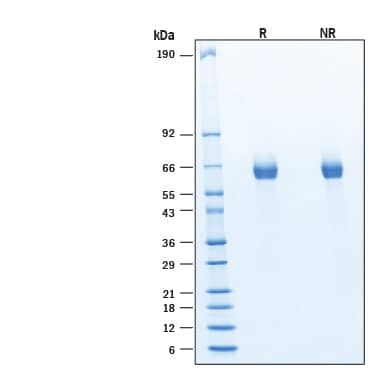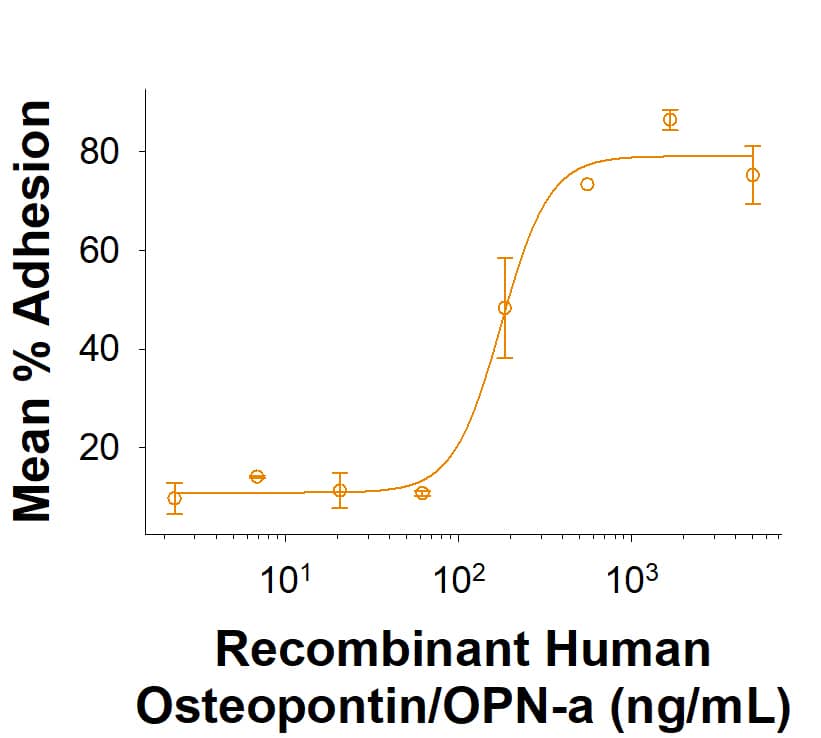Recombinant Human Osteopontin/OPN-a His-tag Protein, CF
R&D Systems, part of Bio-Techne | Catalog # 11437-OP

Key Product Details
- R&D Systems HEK293-derived Recombinant Human Osteopontin/OPN-a His-tag Protein (11437-OP)
- Quality control testing to verify active proteins with lot specific assays by in-house scientists
- All R&D Systems proteins are covered with a 100% guarantee
Product Specifications
Source
Human embryonic kidney cell, HEK293-derived human Osteopontin/OPN protein
Ile17-Asn314 with a C-terminal 6-His tag
Ile17-Asn314 with a C-terminal 6-His tag
Purity
>95%, by SDS-PAGE visualized with Silver Staining and quantitative densitometry by Coomassie® Blue Staining.
Endotoxin Level
<0.10 EU per 1 μg of the protein by the LAL method.
N-terminal Sequence Analysis
Ile17
Predicted Molecular Mass
35 kDa
SDS-PAGE
60-66 kDa, under reducing conditions.
Activity
Measured
by the ability of the immobilized protein to support the adhesion of HEK293
human embryonic kidney cells. The ED50 for this effect is 0.100-1.20
µg/mL.
Scientific Data Images for Recombinant Human Osteopontin/OPN-a His-tag Protein, CF
Recombinant Human Osteopontin/OPN-a His-tag Protein Bioactivity.
Recombinant Human Osteopontin/OPN-a His-tag Protein (Catalog # 11437-OP) supports the adhesion of HEK293 human embryonic kidney cells. The ED50 for this effect is 0.100-1.20 µg/mL.Recombinant Human Osteopontin/OPN-a His-tag Protein SDS-PAGE.
2 μg/lane of Recombinant Human Osteopontin/OPN-a His-tag Protein (Catalog # 11437-OP) was resolved with SDS-PAGE under reducing (R) and non-reducing (NR) conditions and visualized by Coomassie® Blue staining, showing bands at 60-66 kDa, under reducing conditions.Formulation, Preparation and Storage
11437-OP
| Formulation | Lyophilized from a 0.2 μm filtered solution in PBS with Trehalose. |
| Reconstitution | Reconstitute at 500 μg/mL in PBS. |
| Shipping | The product is shipped at ambient temperature. Upon receipt, store it immediately at the temperature recommended below. |
| Stability & Storage | Use a manual defrost freezer and avoid repeated freeze-thaw cycles.
|
Background: Osteopontin/OPN
References
- Scatena, M. et al. (2007) Arterioscler. Thromb. Vasc. Biol. 27:2302.
- Rangaswami, H. et al. (2006) Trends Cell Biol. 16:79.
- Young, M.F. et al. (1990) Genomics 7:491.
- Briones-Orta, M.A. et al. (2017) Biochim Biophys Acta Rev Cancer. 1868(1):93-108.A.
- Weber, G.F. et al. (2002) J. Leukoc. Biol. 72:752.
- Keykhosravani, M. et al. (2005) Biochemistry 44:6990.
- Kazanecki, C.C. et al. (2007) J. Cell. Biochem. 102:912.
- Senger, D.R. et al. (1994) Mol. Biol. Cell 5:565.
- Yokosaki, Y. et al. (2005) Matrix Biol. 24:418.
- Takafuji, V. et al. (2007) Oncogene 26:6361.
- Kiefer, F.W. et al. (2010) Diabetes 59:935.
- Koroknai, V. et al. (2024) Clin Transl Sci. 17(1): e13694.
- Hall, B.K. (2015) Bones and Cartilage (Second Edition).
Long Name
Secreted Phosphoprotein 1 [BNSP]
Alternate Names
Eta-1, OPN, Spp1
Gene Symbol
SPP1
UniProt
Additional Osteopontin/OPN Products
Product Documents for Recombinant Human Osteopontin/OPN-a His-tag Protein, CF
Product Specific Notices for Recombinant Human Osteopontin/OPN-a His-tag Protein, CF
For research use only
